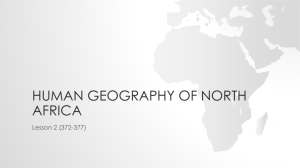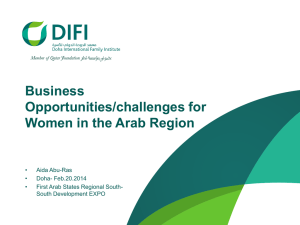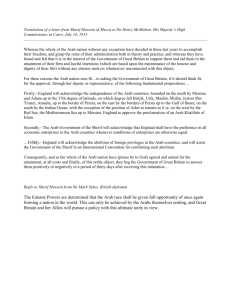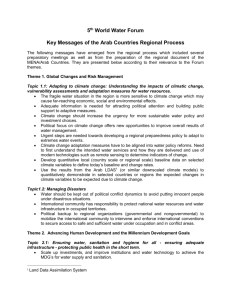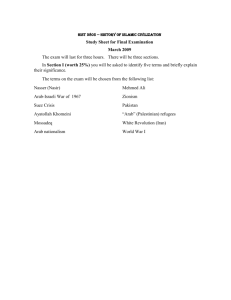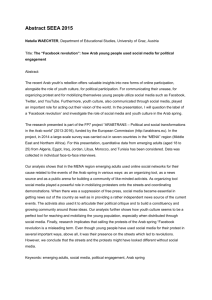PowerPoint Presentation - Arab Climate Resilience Initiative
advertisement
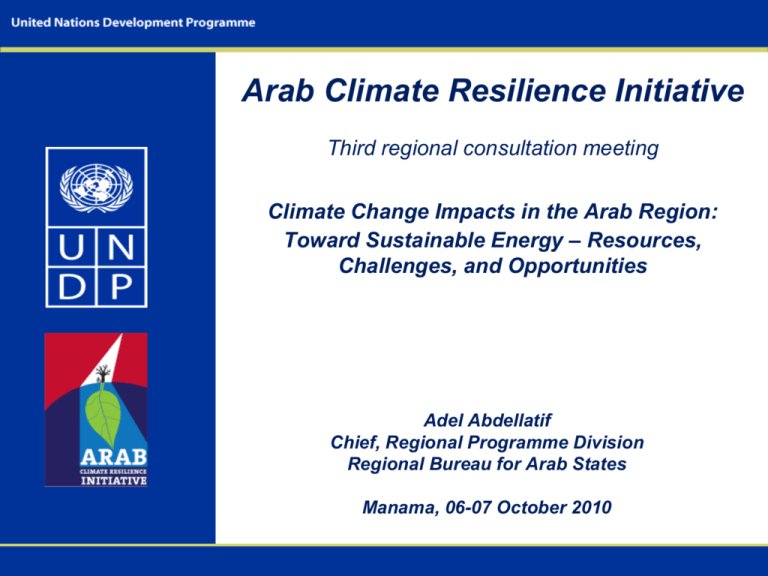
Arab Climate Resilience Initiative Third regional consultation meeting Climate Change Impacts in the Arab Region: Toward Sustainable Energy – Resources, Challenges, and Opportunities Adel Abdellatif Chief, Regional Programme Division Regional Bureau for Arab States Manama, 06-07 October 2010 Climate Change: a concern and an opportunity Climate Change is a concern in the Arab countries Arab Ministerial Declaration on Climate Change (2007) called for policy action ranging from integration of policies to deal with climate change in all sectors, adoption of national and regional climate change action plans, and carrying out studies to better understand the threat and options to deal with it. Declaration of Arab Summit, Libya, March 2010 “We emphasize the need to adopt effective policies in dealing with the issues of climate change and preservation of the environment in all national and regional fields of sustainable development, and to adopt a unified stance at the negotiations over climate change in order to secure the rights of our peoples to safeguard our national resources...We stress the importance of cooperation and coordination in all fields of development, especially in the fields of Arab road links, electricity links, use of sustainable energy, green-belt projects..…” 2 Climate Change: a concern and an opportunity Climate Change is also an opportunity for Arab countries Energy efficiency to expand access; Alternative and renewable energy; Diversified economic growth; Job creation; Opportunity to improve policy coordination. 3 4 The Arab Climate Resilience Initiative Objectives: Principles: Build knowledge and foster policy Consultative and demand-driven; dialogue; In line with priorities as defined by Mobilize experts and policy leaders Arab countries ; to build momentum; Support strategic interventions to Promote regional cooperation; Identify not only challenges, but promote climate resilient development also opportunities. in the Arab countries. 5 The Regional Forum on CC in the Arab countries Participants: Objectives: Discuss and endorse the regional initiative Mobilize high level partners Dates: 3-5 November, 2010 Venue: Rabat, Morocco Governments : Ministers, Parliaments, Decision makers Corporation Agencies and Donors Research and Academic institutions Private sector NGOs Youth Media 6 Content of Presentation Part I: Energy and Development Part II: Energy in the Arab Countries – A Global Responsibility Part III: Sustainable Energy: Challenges in the Region Part IV: Global Renewable Energy Part V: Key Questions 7 PART I: ENERGY AND DEVELOPMENT 8 Part I: Energy and Development • Energy has been at the heart of critical economic, environmental and development issues facing the world today–in developed and developing countries. Sources: World Bank, World Development Indicators (Energy Use) UNDP, Human Development Report Office (HDI) 9 Energy consumption and wealth…the world at night 10 On as the world population increases, and prosperity increases, demand for energy will continue to grow. Source: UN DESA. World Population Prospects, 2010. 11 PART II: ENERGY AND THE ARAB COUNTRIES: A GLOBAL RESPONSIBILITY 12 Part II: Energy in the Arab Countries: A Global Responsibility Source: Calculated from BP Statistical Review of World Energy, 2010. 13 Part II: Energy in the Arab Countries: A Global Responsibility Source: Calculated from BP Statistical Review of World Energy, 2010. 14 Part II: Energy in the Arab Countries: A Substantial Source of Revenue Source: IMF Country Reports, 2010. 15 Part II: Energy in the Arab Countries: Contributing to Human Development Sources: World Bank, World Development Indicators (Energy Production). UNDP, Human Development Report Office (HDI). 16 Part II: Energy in the Arab Countries: Volatility and Jobless Growth Source: UNDP AHDR, 2009. 17 PART III: SUSTAINABLE ENERGY – CHALLENGES IN THE REGION 18 Part III: Energy Sustainability: Challenges in the region A: Population increase and economic growth = growing demand 700 Total population, Arab Region (millions) 598 600 500 400 359 300 200 128 100 0 1970 2010 2050 Source: UN DESA. World Population Prospects, 2009. 19 Part III: Energy Sustainability: Challenges in the region A: Population increase and economic growth = growing demand Source: Tapping a Hidden Resource, Energy Efficiency in the Middle East and North Africa, World Bank 2009. 20 Part III: Energy Sustainability: Challenges in the region B: Energy Use is Highly Inefficient in the Arab Countries Source: Tapping a Hidden Resource, Energy Efficiency in the Middle East and North Africa, World Bank 2009. 21 Part III: Energy Sustainability: Challenges in the region B: Energy Use is Highly Inefficient in the Arab Countries Table: Arab Region is highly inefficient, Energy Intensity in the Arab Region versus the World Average, 2007 Country/Region GDP, PPP (billions of current international US $) Energy use (kt of oil Energy intensity: Energy use per unit of GDP (kg of oil equivalent per PPP equivalent) US $) Algeria 263.06 36863 0.140 Bahrain 24.98 8774 0.351 Comoros 0.73 .. … Djibouti 1.74 .. … Egypt 404.87 67246 0.166 Iraq 94.45 33086 0.350 Jordan 29.39 7201 0.245 Kuwait 128.79 25200 0.196 Lebanon 44.65 3993 0.089 Libya 96.40 17823 0.185 Mauritania 6.03 .. … Morocco 127.16 14361 0.113 Oman 61.19 15479 0.253 Qatar 65.25 22187 0.340 Saudi Arabia 548.30 150326 0.274 Sudan 80.67 14675 0.182 Syria 87.94 19639 0.223 Tunisia 77.12 8837 0.115 United Arab Emirates 245.37 51636 0.210 Yemen 52.22 7212 0.138 Arab Region 2440.30 504538 0.207 World 67672.05 11664890 0.172 Source: UNDP-AHDR calculations based on data from World Bank, 2010 22 Part III: Energy Sustainability: Challenges in the region B: Energy Use is Highly Inefficient in the Arab Countries Source: UNDP-AHDR calculations based on World Bank , 2010. 23 Part III: Energy Sustainability: Challenges in the region C: No strong tradition of investing in Research and Development Source: Arab Knowledge Report, 2009. 24 Part III: Energy Sustainability: Challenges in the region D: Water Scarcity puts pressure on energy Capacity of Production of desalination desalination plants plants (million per day(million Plant number cubic meters/day) cubic meters/day) Source: UNDP, Human Development Report Office. Saudi Arabia 23 3.5 2.91 Kuwait 6 1.44 1.31 Bahrain 3 0.38 0.34 Qatar 2 0.49 0.43 UAE 8 2.61 2.23 Oman 2 0.28 0.19 Source: Al Rukaibi, Duaij (2010). Water resources in the GCC. University of Texas at Austin. 25 Part III: Energy Sustainability: Challenges in the region E: Rising temperatures put pressure on energy Source: Dr. Jeff Masters, Weather Underground. July 30, 2010. 26 PART IV: GLOBAL RENEWABLE ENERGY 27 Part IV: Global Renewable Energy Source: BP statistical review of world energy, 2010. 28 Part IV: Global Renewable Energy Source: BP statistical review of World Energy, 2010. 29 PART V: KEY QUESTIONS 30 Part V: Key Questions What are the overall challenges and opportunities associated with the relationship between energy and climate change? (Opening) What are the features of the global and regional context that enable and or present challenges to sustainable energy? (Panel 1) What can we learn from the innovative renewable energy initiatives underway in the Arab countries, how can these be scaled-up, and what role can they play in regional cooperation? (Panel 2) What economic and financial opportunities can be seized in the embrace of sustainable energy? (Panel 3) What steps can be taken to promote a rapid advance of knowledge and technology transfer for sustainable energy in the Arab countries? (Panel 4) What are the priorities for cooperative action, and how can we move forward together to enhance sustainable energy throughout the region? (Panel 5) 31 THANK YOU FOR YOUR PARTICIPATION 32 “The decisions we take today on how we produce, consume and distribute energy will profoundly influence our ability to eradicate poverty and respond effectively to climate change.” UN SG 33
